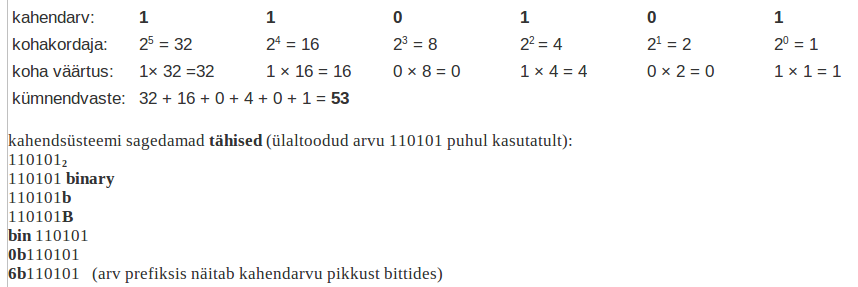binary system
kahendsüsteem
olemus
positsioon-arvusüsteem, mis põhineb kahendnumbritel; alus on 2, st numbrikoha väärtus on kahe aste, mis sõltub positsioonist: täisosa lõpust ettepoole lugedes on astendajad 0, 1, 2 jne, astme väärtused seega on vastavalt (1, 2, 4, 8 jne) × (0 või 1)
ISO/IEC 2382:
püsialusega arvusüsteem, mis kasutab numbreid 0 ja 1 ning alust kaks; näide: selles arvusüsteemis esitab numeraal 110,01 kümnendarvu 6,25; st 1 x 2² + 1 x 2¹ + 1 x 2-2
= the fixed radix numeration system that uses the digits 0 and 1 and the radix two
Example: In the binary system, the numeral 110,01 represents 1 x 2² + 1 x 2¹ + 1 x 2-2 equivalent to the decimal numeral 6,25.
kahendsüsteemi tähised
1) arvu lõpus: binary, b, B
2) alaindeksina: 2
3) arvu ees: bin, 0b, nb (n = bittide arv)
näiteid
kahendarv 110101 esitab kümnendarvu 53:

loetakse
numberhaaval, st 100 on "üks-null-null", mitte "sada"
ülevaateid
https://en.wikipedia.org/wiki/Binary_system
http://www.electronics-tutorials.ws/binary/bin_2.html
https://scholarworks.umt.edu/cgi/viewcontent.cgi?article=1315&context=tme
https://www.eipiphiny.org/books/history-of-binary.pdf